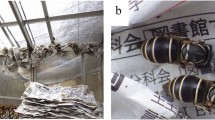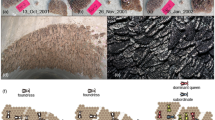Abstract
Social wasps from temperate zones have clear annual colony cycles, and the young queens hibernate during winter. In the subtropics, the only previously reported evidence for the existence of “hibernation” is the facultative winter aggregations of females during harsh climate conditions. As in temperate-zone species analyzed so far, we show in this study that in the paper wasp, Polistes versicolor, a subtropical species, body size increases as an unfavorable season approaches. Our morphological studies indicate that larger females come from winter aggregations—that is, they are new queens. Multivariate analyses indicate that size is the only variable analyzed that shows a relationship to the differences. Given the absence of a harsh climate, we suggest that the occurrence of winter aggregations in tropical P. versicolor functions to allow some females to wait for better environmental conditions to start a new nest, rather than all being obliged to start a new nest as soon as they emerge.





Similar content being viewed by others
References
Anderson TW (1958) Introduction to multivariate statistical analysis. Wiley, New York
Dani FR (1994) Caste size differences in Polistes gallicus (L) (Hymenoptera, Vespidae). Ethol Ecol Evol 3:67–73
Gobbi N (1977) Ecologia de Polistes versicolor (Hymenoptera: Vespidae). Ph.D. Thesis. São Paulo University, SP, Brazil
Gobbi N, Zucchi R (1980) On the ecology of Polistes versicolor versicolor (Olivier) in southern Brazil (Hymenoptera Vespidae, Polistinae): I—phenological account. Naturalia 5:97–104
Gobbi N, Fowler HG, Chaud-Netto J, Nazareth SL (1993) Comparative colony productivity of Polistes simillimus and Polistes versicolor (Hymenoptera: Vespidae) and the evolution of paragyny in the Polistinae. Zool Jahrb Physiol 97:239–243
Gonzalez JA, Nascimento FS, Gayubo SF (2002) Observations on the winter aggregations of two polistine paper wasps (Hymenoptera Vespidae Polistinae). Trop Zool 15:1–4
González JA, Piñango J, Blanco ED, Matthews RW (2004) on the mass aggregations of Polistes versicolor (Olivier) (Hymenoptera: Vespidae) along the northern cordillera of Venezuela, South America. J Hymenopt Res 14:15–21
Hunt JH, Brodie RJ, Carithers TP, Goldstein PZ, Janzen DH (1999) Dry season migration by Costa Rican lowland paper wasps to high elevation cold dormancy sites. Biotropica 31:192–196
Koeppen W (1931) Die Klimate der Erde. Grundiss der Klimakunde. 2 Auf. Berlin
Noll FB, Wenzel JW, Zucchi R (2004) Evolution of caste in neotropical swarm-founding wasps (Hymenoptera: Vespidae; Epiponini). Am Mus Novit 3467:1–24
Queller DC, Strassmann JE (1989) Measuring inclusive fitness in social wasps. In: Breed MD, Page RE (eds) The genetics of social evolution. Genet Sel Evol 103–122. Westview Press, Boulder
Rao CR (1973) Linear statistical inference. Wiley, New York
Reeve HK (1991) Polistes. In: Ross K, Matthews RW (eds) The Social Biology of wasps. Cornell University Press, Ithaca, New York, pp99–148
Richards OW (1978) The social wasps of America excluding the Vespinae. British Museum (Natural History), London
Sólis CR, Strassmann JE (1990) Presence of brood affects caste differentiation in the social wasp, Polistes exclamans Viereck (Hymenoptera, Vespidae). Funct Ecol 4(4):531–541
Spradbery JP (1973) Wasps: an account of the biology and natural history solitary and social wasps. Sidgwick and Jackson and University of Washington Press, London and Seattle
Sullivan JD, Strassmann JE (1984) Physical variability among nest foundresses in the polygynous social wasp, Polistes annularis. Behav Ecol Sociobiol 15:249–256
Wenzel JW (1992) Extreme queen-worker dimorphism in Ropalidia ignobilis, a small-colony wasp (Hymenoptera: Vespidae). Insectes Soc 39:31–43
West-Eberhard MJ (1969) The social biology of Polistinae wasps. Misc Publ Mus Zool Univ Mich 140:1–101
Acknowledgments
We thank Mary Jane West-Eberhard (Smithsonian Institute) and John Wenzel (The Ohio State University) for the corrections and suggestions on the early draft of the manuscript. Kurt M. Pickett and James M. Carpenter (American Museum of Natural History) read the final version and gave important suggestions. This work was supported by grants from FAPESP (Fundação de Amparo à Pesquisa do Estado de São Paulo)—grant # 01-02491-4 and CNPq (Conselho Nacional de Desenvolvimento Científico e Tecnológico)—grant # 300312/2004-0. Specimens were collected under permission from IBAMA (02027.001914/2002-95).
Author information
Authors and Affiliations
Corresponding author
Rights and permissions
About this article
Cite this article
Gobbi, N., Noll, F.B. & Penna, M.A.H. “Winter” aggregations, colony cycle, and seasonal phenotypic change in the paper wasp Polistes versicolor in subtropical Brazil. Naturwissenschaften 93, 487–494 (2006). https://doi.org/10.1007/s00114-006-0140-z
Received:
Revised:
Accepted:
Published:
Issue Date:
DOI: https://doi.org/10.1007/s00114-006-0140-z




